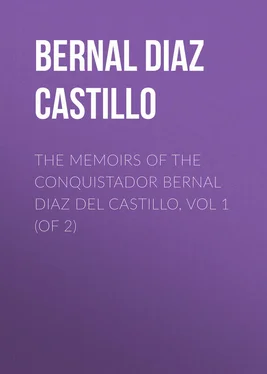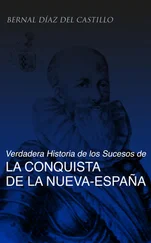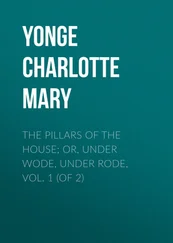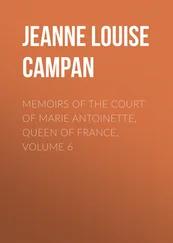Bernal Díaz del Castillo - The Memoirs of the Conquistador Bernal Diaz del Castillo, Vol 1 (of 2)
Здесь есть возможность читать онлайн «Bernal Díaz del Castillo - The Memoirs of the Conquistador Bernal Diaz del Castillo, Vol 1 (of 2)» — ознакомительный отрывок электронной книги совершенно бесплатно, а после прочтения отрывка купить полную версию. В некоторых случаях можно слушать аудио, скачать через торрент в формате fb2 и присутствует краткое содержание. Жанр: foreign_antique, foreign_prose, на английском языке. Описание произведения, (предисловие) а так же отзывы посетителей доступны на портале библиотеки ЛибКат.
- Название:The Memoirs of the Conquistador Bernal Diaz del Castillo, Vol 1 (of 2)
- Автор:
- Жанр:
- Год:неизвестен
- ISBN:нет данных
- Рейтинг книги:3 / 5. Голосов: 1
-
Избранное:Добавить в избранное
- Отзывы:
-
Ваша оценка:
- 60
- 1
- 2
- 3
- 4
- 5
The Memoirs of the Conquistador Bernal Diaz del Castillo, Vol 1 (of 2): краткое содержание, описание и аннотация
Предлагаем к чтению аннотацию, описание, краткое содержание или предисловие (зависит от того, что написал сам автор книги «The Memoirs of the Conquistador Bernal Diaz del Castillo, Vol 1 (of 2)»). Если вы не нашли необходимую информацию о книге — напишите в комментариях, мы постараемся отыскать её.
The Memoirs of the Conquistador Bernal Diaz del Castillo, Vol 1 (of 2) — читать онлайн ознакомительный отрывок
Ниже представлен текст книги, разбитый по страницам. Система сохранения места последней прочитанной страницы, позволяет с удобством читать онлайн бесплатно книгу «The Memoirs of the Conquistador Bernal Diaz del Castillo, Vol 1 (of 2)», без необходимости каждый раз заново искать на чём Вы остановились. Поставьте закладку, и сможете в любой момент перейти на страницу, на которой закончили чтение.
Интервал:
Закладка:
The day following the cross and altar were erected, and the figure of the holy Virgin being placed thereon: we all fell down upon our knees before it, while father Bartolome de Olmedo read mass. The caziques and chief Indians were present. On this occasion also the village of Tabasco was in all solemnity named Santa Maria de la Vitoria; and father Olmedo, with the assistance of Aguilar, said many excellent things to the twenty females who were presented to us, concerning our holy religion; that they should abandon their belief in idols, and no longer bring them sacrifices, for they were not gods but evil spirits; they had up to this moment lived in gross error, and should now adore Christ, our Lord. After this address the women were baptized, and she of whom I have already spoken was named Doña Marina. This was a lady of distinction, the daughter of a powerful cazique and a princess who had subjects of her own, which, indeed, you might see from her appearance. The circumstances which occasioned her being brought into our power I will relate hereafter. The names of the other Indian females who were baptized I cannot now bring to mind; but these were the first who were converted to Christianity in New Spain, and were distributed among Cortes's chief officers. Doña Marina, who was the prettiest, the most active and lively of the number, was given to Puertocarrero, who was a stout cavalier and cousin to the earl of Medellin. When he subsequently left for Spain, Cortes took Marina unto himself, and had a son by her, who was named Don Martin Cortes, and became Comptoir of Santiago.
We remained five days in this spot, partly to cure our wounds, partly for the sake of those who suffered from pain in the groins, but who soon recovered here. Cortes employed these days in useful conversation with the caziques, and talked to them about the emperor, our master, of his numerous lordly vassals, and the advantage they would gain by having subjected themselves to him; as, for the future, in all their difficulties they would only have to apply to him, and wherever he might be he would come to their assistance.
The caziques thanked him for this offer; they solemnly declared themselves to be vassals of our great emperor, and these were the first among the inhabitants of New Spain who subjected themselves to his majesty. As the day following was Palm Sunday, Cortes desired them to come early in the morning to pray before the holy mother of God and the cross. He also sent for six Indian carpenters to assist ours in making a cross on a high ceiba tree, 13 13 The bombax ceiba of Linnæus, and one of the tallest trees growing in America. The fruit produces a very fine cotton, resembling silk, used for stuffing bolsters and chair seats. (p. 82 .)
near the village of Cintla, where the Lord had granted us the great victory. This cross was made in a manner so as to be very durable, for the bark of the tree, which always grows to again, was so cut as to form that figure. Lastly, Cortes desired the Indians to bring out all their canoes in order to assist us in re-embarking, for we were desirous of setting sail on that holy day, as, according to our pilots, our present station was not secure from the north winds.
Early the next morning the caziques and the principal personages, all with their wives and children, made their appearance in the courtyard, where we had erected the altar and cross, and collected the palm branches for our procession. Upon this Cortes, with the officers and all our men, rose and made a solemn procession. Both our priests, the father Bartolome de Olmedo, belonging to the order of the charitable brethren, and Juan Dias, were dressed in their full canonicals, and read mass. We prayed before the cross and kissed it, the caziques and Indians all the while looking on. After the ceremony was finished the principal Indians brought ten fowls, baked fish, and all kinds of greens, which we enjoyed very much. We now took our leave, and Cortes repeatedly recommended them to take care of the image of the holy Virgin and the cross, and to hold the chapel in due reverence, in order that salvation and blessings might come upon them.
We all embarked in the evening, and on Monday morning we set sail with a good wind. We always kept close to the shore, and steered in the direction of San Juan de Ulua. As we coasted along, the weather being most favorable, we who had been here with Grijalva, and were well acquainted with these parts, pointed out to Cortes La Rambla, which the Indians call Aguajaluco; further on, the coast of Tonala or San Antonio, the great river Guacasualco, the elevated snow mountains (sierras nevadas), and those of San Martin. We also showed him the split rock forming two points, which stretch out into the sea, and somewhat resemble the figure of a chair. We then showed him the river Alvarado; further on the river Banderas, where we made the 16000 pesos; the Isla Blanca and Isla Verde, also the Isla di Sacrificios, where, under Grijalva, we found the idols with the Indians who had been recently sacrificed.
In this way we pretty quickly arrived at San Juan de Ulua, which we reached on Holy Thursday about noon. I shall never forget how Alonso Hernandez Puertocarrero just about this time remarked to Cortes: "Methinks we are now certainly arrived in that country, of which those gentlemen who have been here twice before, sung: 14 14 Cata Francia, Montesinos, &c. This is the first strophe of an old Spanish romance, in which Montesinos the father desires his son to revenge him of his mortal enemy Tomillas: "Montesinos cast a glance On your lands, the soil of France; See how the Duro's sportive motion Carries its waters to the ocean!" (p. 83 .)>
'Cata Francia, montesinos!
Cata Paris, la Ciudad,
Cata las aguas de Duero,
Do van a dar en la mar!'
"I tell you, only look at this rich country, and keep strict command over us." Cortes, who well knew what he meant, said in return: "If God will only grant us that good fortune in arms which he gave to Roland, the Paladin, then with your assistance and that of the other gentlemen cavaliers, we shall succeed in everything else." This happened just at the moment when Cortes was entering the river Alvarado, which circumstance is also mentioned by Gomara.
CHAPTER XXXVII
How Doña Marina herself was a caziquess, and the daughter of distinguished personages; also a ruler over a people and several towns, and how she came to Tabasco.
Previous to going into any details here respecting the powerful Motecusuma, his immense kingdom of Mexico, and its inhabitants, I must relate what I know of Doña Marina. She was born a ruler over a people and country, – for her parents had the dominion of a township called Painala, to which several other townships were subject, lying about twenty-four miles from the town of Guacasualco. Her father died when she was very young, and her mother married another young cazique. By him she had a son, of whom it appears they were both very fond, and to whom, after their death, they designed to leave their territories. In order, however, that the daughter of the first marriage might not stand in his way, she was conveyed secretly during night-time to an Indian family in Xicalango, they spreading the rumour she had died, which gained further belief from the circumstance that a daughter of one of her female slaves happened to die at the time. The Indians of Xicalango did not keep the young girl themselves, but gave her to the inhabitants of Tabasco, by whom she was presented to Cortes. I knew her mother and half-brother myself, the latter having already reached manhood, and governed the township jointly with his mother. When they were subsequently both converted to Christianity, the latter was named Martha and her son Lazaro. I was well acquainted with the whole of this circumstance; for in the year 1523, when Mexico and several other provinces had been subdued, and Christobal de Oli had rebelled in the Higueras, Cortes came to Guacasualco, and on that occasion visited Marina's birth-place. Most of the inhabitants of Guacasualco accompanied Cortes on this expedition; I myself was also among the number. As Doña Marina, in all the wars of New Spain, Tlascalla, and at the siege of Mexico, had rendered the greatest services in capacity of an interpretress, Cortes carried her everywhere with him. During this journey it also was that he married her to a cavalier of the township of Orizava, named Juan Xaramillo. Among others, there was present as a witness a certain Aranda of Tabasco, through whom this circumstance became immediately known. These are the true particulars of the whole case, not, however, as related by Gomara. For the rest, Marina had the most extensive influence in New Spain, and did with the Indians what she pleased.
Читать дальшеИнтервал:
Закладка:
Похожие книги на «The Memoirs of the Conquistador Bernal Diaz del Castillo, Vol 1 (of 2)»
Представляем Вашему вниманию похожие книги на «The Memoirs of the Conquistador Bernal Diaz del Castillo, Vol 1 (of 2)» списком для выбора. Мы отобрали схожую по названию и смыслу литературу в надежде предоставить читателям больше вариантов отыскать новые, интересные, ещё непрочитанные произведения.
Обсуждение, отзывы о книге «The Memoirs of the Conquistador Bernal Diaz del Castillo, Vol 1 (of 2)» и просто собственные мнения читателей. Оставьте ваши комментарии, напишите, что Вы думаете о произведении, его смысле или главных героях. Укажите что конкретно понравилось, а что нет, и почему Вы так считаете.












